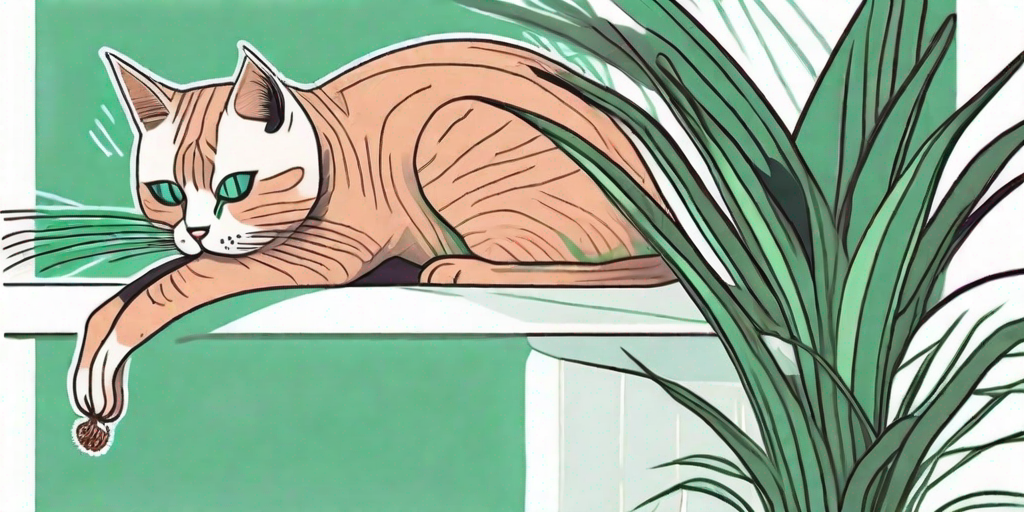
If you're a proud plant parent and a feline fanatic, you're likely familiar with the age-old struggle of keeping your green babies safe from curious kitties. Spider plants, with their long, enticing tendrils, are particularly irresistible to our feline friends. But what happens when your cat decides to turn your beloved spider plant into a mid-afternoon snack? Fear not, dear reader, for we have the purr-fect solution to your cat-astrophe.
The Feline-Spider Plant Love Affair: A Tale as Old as Time
Firstly, let's delve into the mysterious allure of the spider plant for our feline companions. Spider plants, also known as Chlorophytum comosum, are non-toxic to cats and dogs, making them a safe, albeit frustrating, target for your pet's attention. The long, arching leaves of the spider plant are perfect for batting, chewing, and general cat-related shenanigans.
Some experts believe that cats are attracted to spider plants because they mildly hallucinogenic to cats, similar to catnip. However, this theory is not universally accepted, and the spider plant's appeal may simply be its enticing, toy-like appearance. Regardless of the reason, it's clear that cats and spider plants are a match made in mischief heaven.
Reviving Your Spider Plant: The Green Thumb's Guide
Now that we've explored the why, let's move on to the how. How do you revive your spider plant after it's been used as a feline chew toy? Here's a step-by-step guide to get your plant back to its former glory.
Step 1: Assess the Damage
Firstly, take a good look at your plant. Are all the leaves damaged, or just a few? If only a few leaves are chewed, you're in luck. Simply trim off the damaged parts with a clean, sharp pair of scissors. If the majority of the leaves are damaged, you may need to take more drastic action.
Step 2: Prune and Propagate
If your plant is severely damaged, you may need to propagate new plants from the remaining healthy leaves. To do this, cut off a healthy leaf at the base, and place it in a glass of water. Within a few weeks, you should see roots starting to grow. Once the roots are a few inches long, you can plant your new spider plant in soil.
Step 3: Provide Optimal Care
Spider plants are relatively hardy, but they still need proper care to thrive. Ensure your plant is in a well-draining pot and is watered regularly, but not over-watered. Spider plants prefer bright, indirect light, so place your plant near a window, but not in direct sunlight.
Also, remember to feed your spider plant with a balanced houseplant fertilizer every month during the growing season (spring and summer). This will provide the necessary nutrients for your plant to grow strong and healthy.
Preventing Future Cat-astrophes
Once you've revived your spider plant, you'll want to take steps to prevent future feline snack attacks. Here are a few strategies that may help:
Provide Cat-Friendly Alternatives
If your cat is constantly chewing on your spider plant, they may be bored or lacking certain nutrients in their diet. Consider providing cat-friendly plants like cat grass or catnip for them to chew on. This can divert their attention away from your spider plant and provide them with a healthy outlet for their chewing instincts.
Use Deterrents
There are several cat-safe deterrents available that can discourage your cat from chewing on your plants. These include citrus peels, which cats dislike the smell of, and bitter apple spray, which tastes unpleasant to cats. Experiment with different deterrents to see what works best for your feline friend.
Train Your Cat
With patience and consistency, you can train your cat to leave your plants alone. Whenever you see your cat approaching your spider plant, distract them with a toy or treat. Over time, they should learn to associate the plant with the distraction, and leave it alone.
Frequently Asked Questions
- Are spider plants toxic to cats?
No, spider plants are not toxic to cats. However, excessive chewing can cause mild digestive upset, so it's best to keep your cat and your spider plant separated if possible.
- Why does my cat keep eating my spider plant?
Cats may be attracted to spider plants for a variety of reasons, including boredom, a lack of certain nutrients in their diet, or simply because they find the long, arching leaves fun to play with.
- How can I keep my cat away from my spider plant?
There are several strategies you can try, including providing cat-friendly alternatives, using deterrents, and training your cat. What works best will depend on your cat's individual personality and preferences.
In conclusion, while a feline snack attack on your spider plant can be frustrating, it's not the end of the world. With a little TLC, your spider plant can be revived and restored to its former glory. And with a few preventative measures, you can hopefully avoid future cat-astrophes in your garden.















